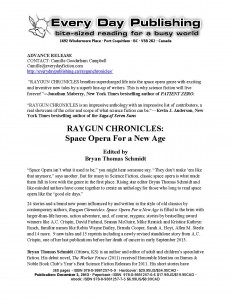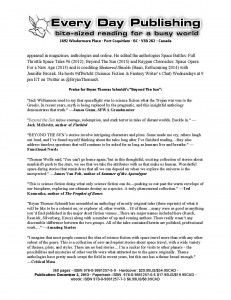Okay, it’s been a few months since I did one of these. I’ll admit, my well was running dry and needed a break to refresh. But I’m going to pick it back up now with a subject that many authors and even small publishers might benefit from: creating releases to go with review copies as you send them out.
If you’re not on a list to receive ARCS from majors, you may not have seen one. But all ARCs (Advanced Review Copies) come with a press release containing key information about the book. They are easy to create. I did mine in Word. And yet, they entice the recipient to read as well as making it easy for them to find key information about the author and book in case they want to write reviews, do interviews, or more.
I recently made these for my latest anthologies and here’s what they look like for Raygun Chronicles:


So let’s break it down. First, your header should include the publisher’s logo and primary business address.
The footer should include the meta data about the book (as shown), including page count, release date, sale price, ISBN, format, etc.
360 pages · ISBN 978-0-9881257-5-9 · Hardcover: $29.95US/$34.95CAD ·
Publication: December 3, 2013 · Paperback: ISBN 978-0-9881257-6-6 $17.95US/$19.95CAD ·
ebook: ISBN 978-0-9881257-7-3 $6.99US/$8.99CAD
Usually centered. This is the key information for both reviews and articles as well as booksellers and others who might want to order the book.
The header and footer should be the same on every page of the release. And I should tell you, two pages is usually more than enough. In fact, most are a page and a half.
Now let’s look at what lies between.
First, at the top right corner, put contact information. An email address, name hyperlink and even phone number if you want, usually for a publicist or publisher who will serve as key point of contact for inquiries about the book. Sometimes the release date is also included in bold above this information.
Next, key quotes. If you’re fortunate enough to have early reviews or blurbs back, use them. If they’re too long, trim or use judicious ellipses, but don’t change the meaning of anything. This is very important. You will be called on it and having those kinds of questions raised in the middle of a release is not advisable. It’s an unneeded distraction at the least.
Then, centered, in large text and bold, Title and author’s name as a reminder which book this release pertains to. After all, most reviewers and interviewers get many ARCs and releases and they can be easily separated and all look alike. Make it easy for them to be matched up again if necessary.
Then a brief summary about the book, using your best exciting, sales language, of course, to make them want to read.
This should be followed by a bio of the author. 100-150 words should suffice. Less if possible. Concise and quick is what matters here. You want to excite and tease them but not make them stop reading.
Then after the bio, usually on page 2 (as shown) include blurb clips from author’s previous work. Sometimes there can be images of the book, but these increase printing cost. Often a list of the author’s other titles with ISBNs and prices is included.
Regardless, this is the standard information for such releases. The purpose is to get the recipient to prioritize attention to the book in question. And so keep it concise, clean, and positive. But also be honest and don’t overdo it. After all, the book should speak for itself. Remember, with all the requests inundating them and the fact that not every book, subject or author appeals to everyone, your book may not be chosen. Sometimes they’ve reviewed too much in that genre recently or even an0ther of your books. Sometimes, there are other reasons. Regardless, getting it into their hands and getting their attention is your job. What happens after that is not.
Printing these double sided is a good idea, but stapled double pages is also common. Regardless, they are easy to make and cheap to print and they will make even your self-published or micropress book look professional alongside the books from the majors. Provided your cover design and layout can compete, that is. But that’s a different post.
So that’s how to make your own professional Release Cover Letters For Review Copies of your books. I hope it’s useful. For what it’s worth…
 Bryan Thomas Schmidt is an author and editor of adult and children’s speculative fiction including the novels The Worker Prince and The Returning, and the children’s books 102 More Hilarious Dinosaur Jokes For Kids (ebook only) and Abraham Lincoln: Dinosaur Hunter- Land Of Legends. His debut novel, The Worker Prince (2011) received Honorable Mention on Barnes & Noble Book Club’s Year’s Best Science Fiction Releases for 2011. His short stories have appeared in magazines, anthologies and online. He edited the anthologies Space Battles: Full Throttle Space Tales #6 (Flying Pen Press, 2012), Beyond The Sun (Fairwood, July 2013), and Raygun Chronicles: Space Opera For a New Age (Every Day Publishing, November 2013) and is working on Shattered Shields with co-editor Jennifer Brozek (Baen, 2014). He also hosts #sffwrtcht (Science Fiction & Fantasy Writer’s Chat) Wednesdays at 9 pm ET on Twitter and can be found via Twitter as @BryanThomasS, on his website atwww.bryanthomasschmidt.net or Facebook.
Bryan Thomas Schmidt is an author and editor of adult and children’s speculative fiction including the novels The Worker Prince and The Returning, and the children’s books 102 More Hilarious Dinosaur Jokes For Kids (ebook only) and Abraham Lincoln: Dinosaur Hunter- Land Of Legends. His debut novel, The Worker Prince (2011) received Honorable Mention on Barnes & Noble Book Club’s Year’s Best Science Fiction Releases for 2011. His short stories have appeared in magazines, anthologies and online. He edited the anthologies Space Battles: Full Throttle Space Tales #6 (Flying Pen Press, 2012), Beyond The Sun (Fairwood, July 2013), and Raygun Chronicles: Space Opera For a New Age (Every Day Publishing, November 2013) and is working on Shattered Shields with co-editor Jennifer Brozek (Baen, 2014). He also hosts #sffwrtcht (Science Fiction & Fantasy Writer’s Chat) Wednesdays at 9 pm ET on Twitter and can be found via Twitter as @BryanThomasS, on his website atwww.bryanthomasschmidt.net or Facebook.


Thank you. I was wondering about this. The follow-up question is WHERE and how to you send/address your novel and release? Thanks 🙂
I have no idea what my publisher sends…
Well, they sent a release like described above, a bookmark, and postcards for each of your prior books. 🙂
“they are easy to make and cheap to print and they will make even your self-published or micropress book look professional alongside the books from the majors.”
Sorry, my mistake 🙂 Thanks I’ll look around for some info on self-pub review submissions.
Tam, I’m not sure what you mean by “my mistake,” I hadn’t responded to your first comment yet. The other was for Alex. And that’s because you are asking something I could do a whole other blog post about. Where to submit is a huge subject. One place to start with science fiction and fantasy book bloggers is this list: https://bryanthomasschmidt.net/sffwrtcht/2011/08/16/sf-reviewer-blogs-list-from-grasping-for-the-wind-com/ Now, if you are in a different genre, I’ll admit to being less informed but Publisher’s Weekly, Library Journal and Kirkus are the biggees across the genres, but they have very strict guidelines for how to submit, when and what they’ll even consider. Kirkus, for example, doesn’t do Print on Demand books at all. And all refuse self-pubbed unless you pay a fee, which is not cheap and not recommended. Beyond that, ask around, observe on Twitter and Facebook who other authors in your genres are sending books to, where they’re getting reviewed, etc. and then try and identify a contact rather than sending to a general mailbox so you can personalize your cover when sending things in. Also find out if they take ebooks for review or require print copies. Some may require two copies. Then it’s a matter of weighing if you consider that site’s view to be valuable enough to give paper copies or not. It’s not cheap and it adds up quick. Those are just a few tips at least to get you started.
Bryan, do you see this changing — “And all refuse self-pubbed unless you pay a fee”?
The publishing world has changed and self-publishing is no longer just a vanity press. There are many excellent self-published books because good authors get tired of the out-of-date mindset and criteria too many dinosaur publishing houses maintain. Two years to get physically published AFTER however long it takes to get accepted in the first place. No help with marketing and promotion, especially for first-time authors. A few weeks on the shelves before being yanked. Being relegated to “out of print” not much longer after that.
There are many valid reasons to self-publish in today’s world, not the least of which is that most sales today are via Amazon, removing much of the need for an agent and publishing house (and their cut of your income).
My self-published book was professionally edited and the cover was professionally designed. I used Amazon as a vehicle but did not cut corners on the quality of my book (including the writing itself). Yet I am shut out from submissions to reviewers and even from being selected to participate in festivals such as the nearby (to me) Texas Book Festival. It is frustrating.
So I ask again, do you see this changing? Would love for you to blog about this.
Janet
Janet, not any time soon, and, frankly, I don’t blame them. I don’t invite self-pubbed authors to my twitter chat interviews much either. There’s just too many and I can’t be gatekeeper of quality without sucking up way too much time. Major review sites have the same problem. There are sites that focus on small press and indie now, however, and many of them get good traffic. If your book somehow draws extraordinary interest or you can afford to hire a publicist, you might break through but it’s hard. And until more authors take enough pride in professionalism to make sure their self-published works are professional, it won’t change. Too many people still see it as a get rich quick way to money and “fame” for it to be otherwise.